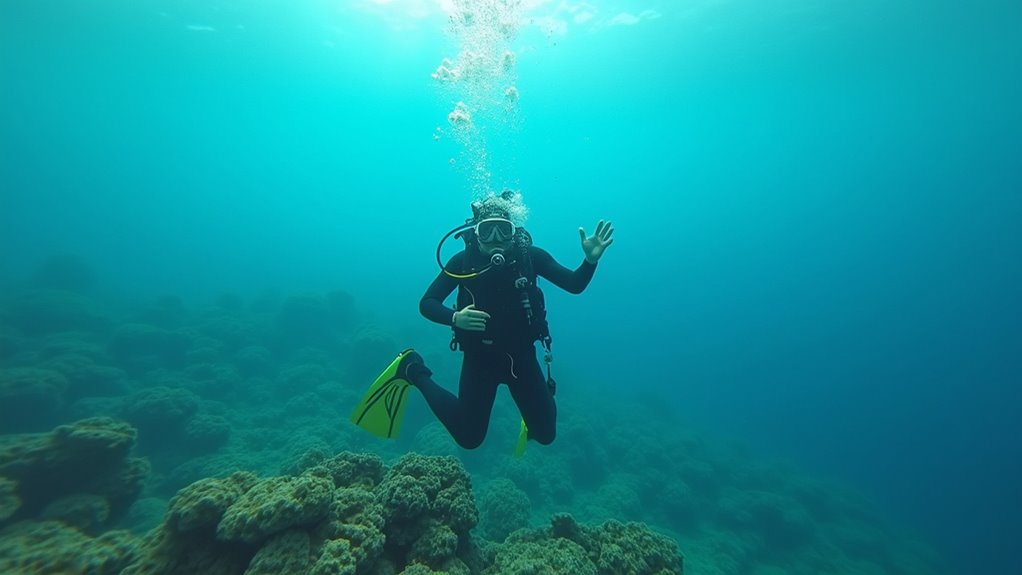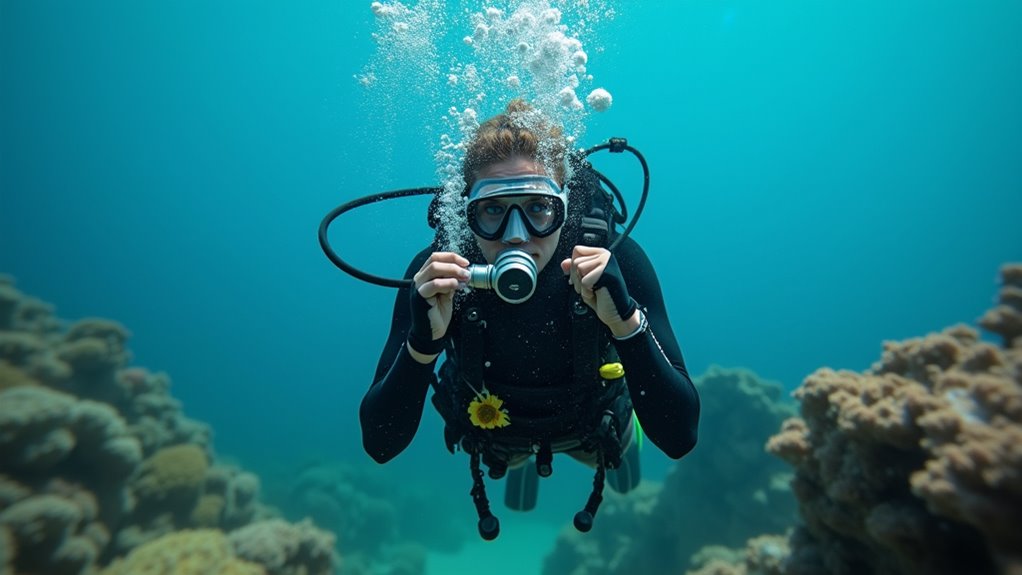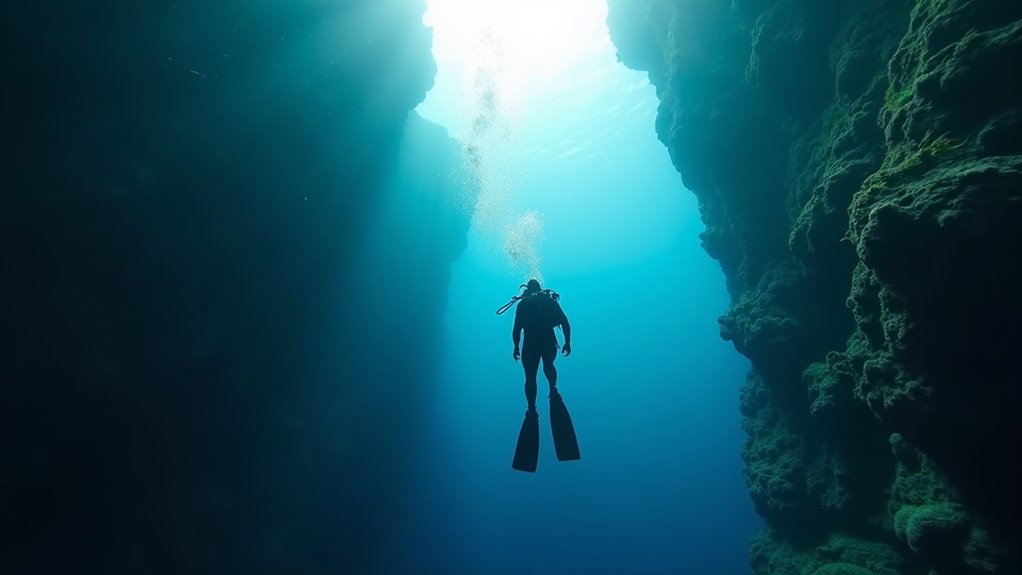Physical Address
304 North Cardinal St.
Dorchester Center, MA 02124
Physical Address
304 North Cardinal St.
Dorchester Center, MA 02124

Critical scuba diving mistakes claim lives yearly—discover the seven deadly errors that even experienced divers make underwater.
You probably don’t realize that most diving accidents stem from preventable mistakes rather than equipment failures or marine life encounters. Even experienced divers can fall into dangerous habits that compromise their safety and enjoyment underwater. Whether you’re planning your first open water dive or you’ve logged hundreds of hours, certain critical errors can turn your underwater adventure into a nightmare. These seven common mistakes continue to catch divers off guard, but knowing what they are will help you stay safe and make the most of every dive.

Before you zip up your wetsuit and take that giant stride into the blue, you’ve got one critical checkpoint that can make or break your dive – the pre-dive safety check. Rushing through your BWRAF (Begin With Review And Friend) check isn’t just poor form; it’s dangerous. You’re fundamentally gambling with your life when you skip testing your regulator, checking your air supply, or verifying your BCD inflates properly.
Many experienced divers get cocky and bypass these steps, thinking muscle memory’s enough. Wrong. Equipment fails, connections loosen, and batteries die – often when you least expect it.
Take those extra five minutes to methodically verify everything works. Your dive buddy‘s life depends on your gear functioning correctly too. Make pre-dive checks non-negotiable, every single time. This systematic approach to equipment inspection helps prevent the most common diving accidents that occur due to preventable equipment malfunctions.
While you’re mesmerized by that gorgeous coral reef or tracking a sea turtle, your air gauge and dive computer are screaming for attention – and ignoring them is one of the fastest ways to turn a perfect dive into a life-threatening emergency.
You must check your air supply every few minutes, not just when you remember. Many divers get so absorbed in underwater photography or marine life encounters that they forget basic monitoring.
Getting lost in underwater beauty while your air gauge drops to dangerous levels is a deadly rookie mistake.
Your dive computer isn’t just expensive jewelry – it’s tracking your depth, bottom time, and decompression limits in real-time.
Set a firm rule: start your ascent with at least 50 bar (700 psi) remaining for shallow dives, more for deeper ones. Never push your no-decompression limits, and always surface with a safety margin.
Just as camping trips require reliable water purifiers to prevent dangerous contamination, your diving instruments serve as critical safety barriers between you and underwater hazards.
Your instruments are your lifeline underwater.

When nitrogen bubbles form in your bloodstream like a shaken soda bottle, you’re experiencing decompression sickness – and it happens because you rushed to the surface without giving your body time to safely release absorbed nitrogen.
Your ascent rate shouldn’t exceed 30 feet per minute, but many divers treat surfacing like an elevator ride.
You’ll need safety stops at 15 feet for three minutes on every dive, plus additional decompression stops if you’ve pushed your no-decompression limits.
Don’t let excitement or panic drive your ascent. That incredible manta ray or low air alarm doesn’t justify skipping stops.
Plan your dive profile beforehand, monitor your computer religiously, and remember that “bend and mend” isn’t just an old diving saying – it’s a painful reality you’ll desperately want to avoid.
Just as whitewater rafters follow essential safety tips to prevent accidents, divers must adhere to proven ascent protocols to avoid serious injury.
Since mastering buoyancy control takes time and practice, many divers crash into coral reefs, slam against boat hulls, or drag their gear across the ocean floor – destroying both marine life and expensive equipment in the process.
You’ll quickly learn that poor buoyancy control isn’t just embarrassing – it’s expensive. Crashing into reefs can crack your mask, damage regulators, or tear fins. Dragging equipment across rocky bottoms destroys gauges and computer housings. Uncontrolled ascents can slam you into boat hulls, potentially breaking cameras or cutting yourself.
Practice neutral buoyancy in shallow water before attempting deeper dives. Master your breathing patterns – small inhales and exhales control minor depth changes. Adjust your BCD in small increments, and always check your weighting before entering the water. Proper buoyancy protects both your wallet and underwater ecosystems.
After a challenging dive with multiple buoyancy mishaps, you’ll need reliable ways to clean salt, sand, and grime from your damaged gear, which is where portable camping showers become invaluable for proper equipment maintenance.

Although certification cards might seem like arbitrary pieces of plastic, they represent critical safety boundaries that separate manageable risks from potentially fatal situations. Your certification level isn’t just about depth limits—it’s about your proven ability to handle emergencies at specific conditions.
Diving beyond your training creates dangerous knowledge gaps. You won’t recognize warning signs, understand equipment limitations, or know proper emergency procedures for unfamiliar environments.
Here’s what happens when you exceed your limits:
Many diving accidents stem from overconfidence in abilities, where divers attempt challenging dives that require skills and knowledge beyond their current certification level.
Respect your certification boundaries. They’re written in other divers’ blood, not bureaucratic red tape.
Your dive buddy becomes your lifeline the moment you descend below the surface, yet many divers treat underwater communication like an afterthought. This mistake can turn minor issues into emergencies.
Before entering the water, establish clear hand signals beyond basic certifications. Discuss your dive plan, including maximum depth, bottom time, and air reserves for ascent. Many divers assume their buddy knows standard signals, but interpretations vary between training agencies and cultures.
Practice emergency signals until they’re second nature. The “something’s wrong” signal differs from “I’m out of air” – know both. Maintain visual contact throughout your dive, and don’t ignore your buddy’s attempts to communicate.
When equipment malfunctions or you feel uncomfortable, signal immediately. Delayed communication underwater has caused countless diving accidents that proper buddy protocol could’ve prevented. Just as with boat rentals, proper preparation and understanding your equipment before use can prevent costly mistakes and dangerous situations.

While most divers focus on perfect buoyancy and navigation skills, they often overlook the critical step of planning what happens when things go wrong. You’re gambling with your life if you descend without a solid emergency plan.
Before every dive, you must establish clear protocols with your buddy. Don’t assume you’ll figure it out underwater when panic sets in.
Your emergency planning should include:
Smart divers always have Plan B ready before they need it. Proper vacation preparation with thorough emergency planning is what separates memorable diving experiences from potential disasters.
You’ve now learned the seven critical mistakes that can turn your underwater adventure into a nightmare. Here’s a sobering reality: the Divers Alert Network reports that over 70% of diving fatalities could’ve been prevented by following basic safety protocols. Don’t become part of this statistic. Whether you’re exploring coral reefs in the Caribbean or kelp forests in California, these fundamentals aren’t just guidelines—they’re your lifeline. Respect the ocean, and it’ll reward you with unforgettable experiences safely.